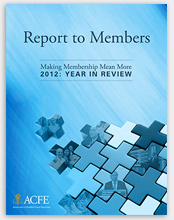Resolve to Protect Yourself From Fraud in 2016
/GUEST BLOGGER
Sarah Hofmann
ACFE Public Relations Specialist
At the beginning of a New Year, many people set goals to embark on a healthier lifestyle. But while you promise to exercise more, or eat less junk food, it is wise to take some time to think about how healthy you are in regards to fraud. All consumers are susceptible to fraud, but many don’t know simple steps they can take to protect themselves. Here are a few simple things you can do in 2016 to protect yourself:
Pay attention to the features of your credit card
On October 1, 2015 all major credit cards in the U.S. were supposed to be switched from using a magnetic strip for authentication to using an embedded EMV chip. In theory, this change is supposed to add an extra layer of security as the embedded EMV chip would create a unique code for each transaction as opposed to just imparting the full credit card data. However, according to a creditcard.com survey, more than 40 percent of consumers had yet to receive EMV cards by the October 1 deadline. In addition to card issuers not sending the new cards, many Americans mistook mail containing the new cards as junk mail and threw them out.
Since transactions using chip cards are harder to hack, fraudsters will no doubt focus much more heavily on stealing data from transactions using only magnetic strip technology. If you have not received an EMV chip card from your card issuer, or if you believe you might have accidentally disposed of the card, it is important to contact the card provider right away and request that a new copy be sent. Also, if possible, try and shop in stores that have working chip-readers integrated into their point-of-sale system. The technology is not fool-proof, but it will be more likely to protect against avoidable data theft.
Be more careful about what you post on social media
It seems like everyone is now using some form of social media on a daily basis, whether it be Facebook, Twitter or LinkedIn. While these can serve as good tools to keep abreast of the lives of friends and family, or to maintain professional connections, they can also help hackers who are trying to steal identities. Something as simple as putting your full birthdate on any social media can allow fraudsters to hack into your important financial accounts.
Some important rules to abide by include never posting your full birthdate, primary email address, hometown, driver’s license number or social security number on any public forum. It is also a good idea to have one constant answer to security questions that is not a logical answer (for example, answering “porcupine” to every question, regardless if it asks what city you were born in, mother’s maiden name etc.) Changing passwords frequently can help, as well as avoiding common password themes such as the names of pets, children or spouses. Another tip is to avoid installing or using applications made available through social media, as they often do not have the same level of security as the social media platform and create an easy back door for hackers to get through.
Protect your tax refund
Every year, hundreds of thousands of Americans request their tax refund and are told it has already been claimed. This is not a new scam, but unfortunately it continues to happen despite what controls are in place at the IRS. ACFE Guardian Award winner Brian Krebs suggests that tax payers file their taxes as early as possible in order to beat would-be thieves to the punch. Another way to prevent refund fraud is to closely monitor your credit score. Consumers can get a free credit report once every year from three different bureaus, so your best bet is to request your credit score from one bureau every four months to see if there is fraudulent activity.
If your tax refund is stolen, you can contact the IRS and fill out forms to officially alert them that the fraud has occurred. That alert can be crucial to helping law enforcement eventually catch the fraudsters responsible for the theft.
While these steps cannot guarantee total immunity from fraudsters, they are simple things that can help you make 2016 a year without fraud.


